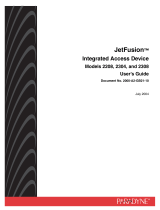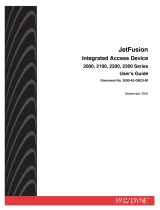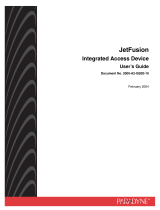Page is loading ...

Part No. 1.024.2320 Rev CA
June 2000
®
R
ELEASE
N
OTES
S
UPER
S
TACK
®
II R
EMOTE
A
CCESS
S
YSTEM
1500
R
ELEASE
2.5
These Release Notes contain information for Release 2.5 of the
SuperStack
®
II Remote Access System 1500 (RAS 1500). It includes the
following:
■ New Features ........................................................................2
■
MSCHAP V1, V2
■
Full Duplex Ethernet
■
File Compression
■
PAT (TCP and UDP) support for WAN Interface
■
NAT (Dynamic and Static) over WAN Interface
■
Web configurator support for WAN Interface
■
GSM
■ Operational Information........................................................9
Visit the RAS 1500 Web Site (http://www.3com.com/ras1500) for the
latest RAS 1500 product information, code, and documentation. On this
site, you will also find a link to the 3Com Knowledgebase where you will
find useful product tips and information posted by other RAS 1500 users.
ISDN Assistance For assistance with Integrated Services Digital Network (ISDN) services in
the U.S., call the 3Com Access Plus hot line, 1-800-367-3869.
When a similar service is available in Canada, information will be posted
on the 3Com Support Web Site (http://support.3com.com).
For assistance with ISDN services in Latin America, contact your local
phone company.
RelNotes2.5.fm Page 1 Thursday, June 8, 2000 2:42 PM

2 R
ELEASE
N
OTES
S
UPER
S
TACK
® II R
EMOTE
A
CCESS
S
YSTEM
1500 R
ELEASE
2.5
New Features
The following are new features in this release:
MSCHAP Version 1
and
MSCHAP Version 2
RAS 1500 includes support for local, Remote Authentication Dial In User
Services (RADIUS) and NT NOS authentication. In addition to Password
Authentication Protocol (PAP) and Challenge Handshake Authentication
Protocol (CHAP) support, Release 2.5 adds MSCHAP Versions 1 and 2 for
local and RADIUS authentication. Versions 1 and 2 are separate protocols
and are incompatible with each other. Therefore, you must set Point To
Point (PPP) Receive Authentication using either Version 1 or Version 2 of
MSCHAP.
You may set PPP Receive Authentication through the Web Configuration
Interface. From the main, browser-based Web Configuration Interface
page, click Authentication under the Administration menu. The
selections for MSCHAPV1 or MSCHAPV2 are under the PPP
Authentication Type pulldown menu.
You may also set PPP Receive Authentication through the Command Line
Interface (CLI). The CLI command to set PPP Receive Authentication using
either Version 1 or Version 2 is as follows:
SET PPP RECEIVE_AUTHENTICATION [ANY CHAP MSCHAPV1 MSCHAPV2
NONE PAP]
Note the use of “any” in the above CLI command example. If you
previously set any scripts using “either” (which was specified in the CLI
command for Version 2.0), you will need to change “either” to “any” in
the script.
Full Duplex Ethernet Ethernet now has full duplex functionality. Full duplex is typically
implemented between two endpoints. Both endpoints of the full duplex
link must operate in full duplex mode in order for full duplex to be fully
operational. If both endpoints are not set for full duplex functionality,
performance may degrade. The CLI command to set full duplex or half is
as follows:
SET ETHERNET DUPLEX_MODE [FULL_DUPLEX HALF_DUPLEX]
Auto-negotiation is not supported on the Ethernet port. Therefore, when
you set full duplex while connected through a switch on the Ethernet
port, make sure you manually set the switch to full duplex mode.
RelNotes2.5.fm Page 2 Thursday, June 8, 2000 2:42 PM

New Features 3
File Compression Release 2.5 includes improved file compression for internal file storage,
increasing the amount of free space on the flash of the Router Unit. This
allows for larger configuration files stored locally on the flash, and
reduces the frequency of RAS 1500 going into ‘Flash Compaction’ mode.
This feature is automatic and you don’t have to do anything to implement
it.
TCP PAT Release 2.5 includes support for Port Address Translation (PAT) over the
WAN interface. Transmission Control Protocol (TCP) PAT sets a static
address mapping translation for a connection and associates a user name
with that connection. TCP PAT translates TCP port numbers and user IP
addresses on the private network and maps these addresses to a single
ISP-assigned address.
You can set PAT through the Web Configuration Interface. From the main
browser-based Web Configuration Interface page, click Select NAT/PAT
Configuration under the Network menu, choose PAT and supply the
following parameters:
■
User name
■ TCP Public Port
■ TCP Private Port
■
TCP Private IP Address
You can also set PAT using CLI. The CLI command for adding TCP PAT
over the WAN interface is as follows:
ADD PAT TCP USER <USER_NAME>
This command should be followed sequentially by the following sub
commands. See the table below for definitions of the parameters.
PRIVATE_ADDRESS <IP_ADDRESS>
PRIVATE_PORT <NUMBER>
PUBLIC_PORT <NUMBER>
Parameter Description
<USER_ NAME> Unique name you assign to the connection that you
want to configure for static TCP PAT.
Limit: 32 ASCII characters.
PRIVATE_ADDRESS The source IP address of the user on the private
network.
RelNotes2.5.fm Page 3 Thursday, June 8, 2000 2:42 PM

4 R
ELEASE
N
OTES
S
UPER
S
TACK
® II R
EMOTE
A
CCESS
S
YSTEM
1500 R
ELEASE
2.5
UDP PAT Release 2.5 includes support for User Data Protocol (UDP) PAT over the
WAN interface. UDP PAT sets a static address mapping translation for a
connection and associates a user name with that connection. UDP PAT
translates UDP port numbers and user addresses on the private network
and maps these addresses to a single ISP-assigned address by changing
the source IP port number and IP address.
You can set UDP PAT through the Web Configuration Interface. From the
main, browser-based Web Configuration Interface page, click Select
NAT/PAT Configuration under the Network menu, choose PAT and
supply the following parameters:
■
User name
■ UDP Public Port
■ UDP Private Port
■
UDP Private IP Address
You can also set UDP PAT using CLI. The CLI command for adding UDP
PAT over the WAN interface is as follows:
ADD PAT UDP USER <USER_NAME>
This command should be followed sequentially by the following sub
commands. See the table below for definitions of the parameters.
PRIVATE_ADDRESS <IP_ADDRESS>
PRIVATE_PORT <NUMBER>
PUBLIC_PORT <NUMBER>
PRIVATE_PORT The source port number on the private network from
which TCP packets are transferred.
PUBLIC_PORT The destination port number of the ISP-assigned IP
address on the public network.
Parameter Description
Parameter Description
<USER_ NAME> Unique name you assign to the connection that you
want to configure for static UDP PAT.
Limit: 32 ASCII characters.
PRIVATE_ADDRESS The source IP address of the user on the private
network.
PRIVATE_PORT The source port number on the private network from
which UDP packets are transferred.
RelNotes2.5.fm Page 4 Thursday, June 8, 2000 2:42 PM

New Features 5
Note: PAT can only be used when the ISP has provided only one IP
address. This one IP address will dynamically change with each new
connection.
Dynamic NAT Release 2.5 includes support for Dynamic Network Address Translation
(NAT) over the WAN interface. Dynamic NAT configures and associates a
name with a specific number of ISP-assigned addresses.
You can set Dynamic NAT through the Web Configuration Interface. From
the main, browser-based Web Configuration Interface page, click Select
NAT/PAT Configuration under the Network menu, choose NAT and
supply the following parameters:
■
User name
■ Starting IP Address
■ Number of Addresses
■
Subnet Mask
You can also set Dynamic NAT using CLI. The CLI command for adding
Dynamic NAT over the WAN interface is as follows:
ADD NAT DYNAMIC USER <USER_NAME>
This command should be followed sequentially by the following sub
commands. See the table below for definitions of the parameters.
COUNT <NUMBER OF ADDRESSES>
PUBLIC_POOL_START<IP_ADDRESS>
PUBLIC_PORT The destination port number of the ISP-assigned IP
address on the public network.
PUBLIC_PORT The port number of the single ISP-assigned IP address
on the public network.
Parameter Description
Parameter Description
<USER_ NAME> Unique name that you want to assign the connection
that uses Dynamic NAT to map ISP-assigned addresses
to connections on the private network. Limit: 32 ASCII
characters.
COUNT Total number of ISP-assigned addresses starting with
the public_pool_start address that is used by the RAS
1500 for Dynamic NAT mapping.
RelNotes2.5.fm Page 5 Thursday, June 8, 2000 2:42 PM

6 R
ELEASE
N
OTES
S
UPER
S
TACK
® II R
EMOTE
A
CCESS
S
YSTEM
1500 R
ELEASE
2.5
Below is an example of Dynamic NAT.
The command,
ADD NAT DYNAMIC USER NATD COUNT 4 PUBLIC_POOL_START 2.2.2.2
sets (the count of) “4” consecutive ISP-assigned addresses beginning with
the ISP-assigned address “2.2.2.2” to use for Dynamic NAT. In this case,
the range includes the ISP-assigned addresses, “2.2.2.2”, “2.2.2.3”,
“2.2.2.4”, and “2.2.2.5”. “NATD” represents the name that is assigned
for the connection for this configured range.
Each time a user connects to the public network, Dynamic NAT translates
the IP address from that user on the private network and maps it to the
first available public IP address from the contiguous range of ISP-assigned
addresses that you configured by using this command. The RAS 1500
maintains a table of active IP addresses on the public network mapped to
user IP addresses on the private network for the connection. Once the
connection to the public network is closed, the information in the table is
dropped and this IP address is free for the next connection. Each time a
user connects to the public network, the next available address from the
contiguous range is assigned, and a new table of mapped addresses is
established by the RAS 1500.
Static NAT Release 2.5 includes support for Static NAT over the WAN interface. Static
NAT configures, and associates a name to, a mapping between and IP
address on the private network to a specific ISP-assigned address on the
public network that uses Static NAT.
You can set Static NAT through the Web Configuration Interface. From
the main, browser-based Web Configuration Interface page, click Select
NAT/PAT Configuration under the Network menu, choose NAT and
supply the following parameters:
■ User name
■
Public IP Address
■
Private IP Address
PUBLIC_POOL_START The first of the contiguous range of IP addresses
assigned by Dynamic NAT mapping.
Parameter Description
RelNotes2.5.fm Page 6 Thursday, June 8, 2000 2:42 PM

New Features 7
You can also set Static NAT using CLI. The CLI command for adding Static
NAT over the WAN interface is as follows:
ADD NAT STATIC USER <USER_NAME>
This command should be followed sequentially by the following sub
commands. See the table below for definitions of the parameters.
PRIVATE_ADDRESS <IP_ADDRESS>
PUBLIC_ADDRESS <IP_ADDRESS>
Below is an example of Static NAT.
The command,
ADD NAT STATIC USER NATS PRIVATE ADDRESS 1.1.1.1 PUBLIC
ADDRESS 2.2.2.2
statically assigns the private address 1.1.1.1 to the ISP-assigned addresses
address “2.2.2.2” to for Static NAT and names this mapping that uses
Static NAT, “NATS”. In this case, 1.1.1.1 always connects to 2.2.2.2. In
this example, “NATS” is the name given to the mapping between the IP
address on the private network and ISP-assigned address on the public
network configured for this Static NAT.
Each time the IP address on the private network, “1.1.1.1” connects to
the public network, Static NAT translates the IP address and connects it to
the static assigned addresses, “2.2.2.2”. The RAS 1500 maintains a table
of active mappings between IP addresses on the private network mapped
to statically assigned IP addresses on the public network.
NAT can only be used when the ISP has provided more than one IP
address. The first and last in the contiguous range of ISP-assigned
Parameter Description
<USER_ NAME> Unique name that you want to assign the connection
that uses Static NAT to map a specific ISP-assigned
address to a specific address on the private network.
PRIVATE_ADDRESS The network address of the host on the private
network that is designated a specific, static public IP
address. This address is always used when connecting
to the public network.
PUBLIC_ADDRESS The public network IP address from the contiguous
range assigned by the ISP, that is reserved for, and
always maps to, the IP address on the private network
configured for Static NAT.
RelNotes2.5.fm Page 7 Thursday, June 8, 2000 2:42 PM

8 R
ELEASE
N
OTES
S
UPER
S
TACK
® II R
EMOTE
A
CCESS
S
YSTEM
1500 R
ELEASE
2.5
addresses are “broadcast” addresses and are not available for NAT. The
second address in the contiguous range is reserved for the RAS 1500 and
also is not available for NAT.
Both Dynamic and Static NAT can be used simultaneously, however
individual users connecting to the public network must be configured for
either dynamic or static NAT. In addition, the IP addresses of users
configured for either NAT type, must be consecutive addresses at the
beginning or end of the series of addresses in the subnet on the private
network.
GSM Release 2.5 includes support for callback to Global Systems for Mobile
Communications (GSM) devices, at the prevailing GSM data rate.
RelNotes2.5.fm Page 8 Thursday, June 8, 2000 2:42 PM

Operational Information 9
Operational
Information
The following operational information is associated with this release:
Closing A Telnet Issue
Resolved
Closing a Telnet session by clicking the box in the top right corner of the
window will now properly close the session.
Lingering User
Sessions Have Been
Eliminated
Faulty handling of certain dial in client disconnects has been corrected.
The symptoms for this problem include:
■ User sessions which no longer exist, remain in the session list.
■ Disconnected users appear active.
■ Apparently random rebooting of the RAS1500. Rebooting of the unit
was caused by the loss of memory, due to the accumulation of
inactive user sessions.
Timing Out
Prematurely During
Dial-Out Resolved
Certain situations in which dialing out from the RAS1500 would time-out
prematurely while waiting for the other side to answer, have been
corrected.
Adding a User When you add a user from the LAN-to-LAN page, to use Frame Relay over
the WAN port, the Permanent Virtual Circuit (PVC) that is created will
have the name that is entered in the "Incoming User Name" field. In the
Shared ISP page, it will be the "ISP Name".
Deleting a Datalink If you want to delete a datalink on the WAN interface, you should do it
through the CLI using the following commands:
RAS1500>DISABLE DATALINK <FRAME_RELAY | PPP> INTERFACE
rm0/wan:1
RAS1500>DELETE DATALINK <FRAME_RELAY | PPP> INTERFACE
rm0/wan:1
Deleting a Frame
Relay PVC
If you want to delete a Frame Relay PVC, you should do it through the CLI
using the following command:
RAS1500>DISABLE USER <USERNAME ASSOCIATED WITH THE PVC>
RAS1500>DISABLE FRAME_RELAY PVC <PVC NAME>
RAS1500>DELETE FRAME_RELAY PVC <PVC NAME>
RelNotes2.5.fm Page 9 Thursday, June 8, 2000 2:42 PM

10 R
ELEASE
N
OTES
S
UPER
S
TACK
® II R
EMOTE
A
CCESS
S
YSTEM
1500 R
ELEASE
2.5
Modifying DLCI The Digital (Data) Link Connection Identifier (DLCI) of a Frame Relay user,
cannot be modified directly from the LAN-to-LAN and Shared ISP pages
of the RAS 1500 Web Configurator. To modify the DLCI, you must use the
CLI.
Perform the following steps to change the DLCI:
a) Go to the CLI and delete the existing PVC and the user using the
following CLI commands:
RAS1500>DISABLE USER <USERNAME>
RAS1500>DISABLE FRAME_RELAY PVC <PVC NAME>
RAS1500>DELETE USER <USERNAME>
RAS1500>DELETE FRAME_RELAY PVC <PVC NAME>
b) Through the Web Configurator, add an entry in the LAN-to-LAN or the
Shared ISP page depending on your requirements, with the new DLCI.
This will add a PVC with the new DLCI.
Changing Datalink RAS1500 allows you to have one datalink on the WAN interface, either
PPP or Frame Relay. You cannot modify a Frame Relay user to PPP Leased
Line or vice versa, in the modify mode in the LAN-to-LAN and Shared ISP
pages of the RAS 1500 Web Configurator. (The same holds true if you
want to change the datalink on the WAN interface from Frame Relay to
Leased Line or vice versa). To change the Datalink, you must use CLI.
Perform the following steps to change a Datalink:
a) Go to the CLI and delete the user.
If you are changing from Frame Relay to PPP Leased Line, use the
following CLI commands:
RAS1500>DISABLE USER <USERNAME>
RAS1500>DISABLE FRAME_RELAY PVC <PVC NAME>
RAS1500>DISABLE DATALINK FRAME_RELAY INTERFACE rm0/wan:1
RAS1500>DELETE USER <USERNAME>
RAS1500>DELETE FRAME_RELAY PVC <PVC NAME>
RAS1500>DELETE DATALINK FRAME_RELAY INTERFACE rm0/wan:1
If you are changing from PPP Leased Line to Frame Relay, use the
following CLI commands:
RAS1500>DISABLE USER <USERNAME>
RelNotes2.5.fm Page 10 Thursday, June 8, 2000 2:42 PM

Operational Information 11
RAS1500>DISABLE DATALINK PPP INTERFACE rm0/wan:1
RAS1500>DELETE USER <USERNAME>
RAS1500>DELETE DATALINK PPP INTERFACE rm0/wan:1
b) You may add a new entry in the LAN-to-LAN or the Shared ISP, through
the Web Configurator, based on your needs.
Frame Relay Local
Management
Interface
The Local Management Interface (LMI) is a set of enhancements to the
basic Frame Relay specification. It is supported by the RAS 1500 and set
ON to ANSI T1.617 Annex –D by default.
However, make sure that your Frame-Relay service provider supports this
feature.
Some Frame-Relay providers require you to turn this feature OFF.
To disable LMI on your WAN port, use the following command at the CLI
prompt
: SET FRAME_RELAY ON INTERFACE RM0/WAN:1 MANAGEMENT_TYPE
NO_LMI
About LMI: LMI virtual circuit status messages provide communication
and synchronization between Frame Relay DTE and DCE devices. These
messages are used to periodically report on the status of PVCs,
preventing data from being sent into black holes (that is, over PVCs that
no longer exist).
The LMI global addressing extension gives Frame Relay DLCI values global
rather than local significance. DLCI values become DTE addresses that are
unique in the Frame Relay WAN.
RelNotes2.5.fm Page 11 Thursday, June 8, 2000 2:42 PM

RelNotes2.5.fm Page 12 Thursday, June 8, 2000 2:42 PM
/




